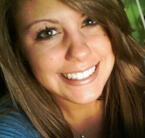
Megan Gwozdecke
Megan Gwozdecke has a hard time remembering her first visit to pediatrician Peter Kwiterovich. After all, that visit occurred two decades ago when she was barely 2 years old. But her mother, Patty Gwozdecke, remembers the visit and the events leading up to it like they were yesterday—especially their pediatrician informing her that Megan’s total cholesterol was over 700, and that she had an extremely rare condition called familial hypercholesterolemia (FH), marked by abnormally high levels of cholesterol in the blood. Those born with it develop early onset fatty buildup inside the arteries that renders them stiff and hardened, which compromises blood flow and makes them vulnerable to heart disease very early in life.
“It was a rough time, to think your child might have a heart attack at age 10,” she says.
The pediatrician referred Megan to a regional children’s hospital near their home in Moonachie, New Jersey, but over the course of a year pediatric cardiologists there could not significantly lower Megan’s cholesterol numbers.
“They said ‘this is beyond our expertise, you need to see this specialist at Johns Hopkins, one of the top guys on the East Coast for lipid disorders,’” says Patty Gwozdecke. “I said ‘Okay, we’ll go wherever we need to go for our daughter.’”
Kwiterovich, the Gwozdeckes learned, was indeed considered by many a pioneer in the field of lipid research and treatment, leading many of the early studies of children and adults diagnosed with FH. Among his findings was the identification of a pair of proteins that—like HDL (high density lipoprotein) and LDL (low density lipoprotein)—may accurately predict coronary artery disease. Also, Kwiterovich was a principal investigator in the Triad Heart Study, which showed that the predisposition to develop LDL is often inherited. Attracting some 2,000 pediatric and adult patients from near and far, Kwiterovich’s clinic provided other investigators a unique opportunity to collect and compare biochemical and genetic data among multiple generations.
“He really started off this idea about identifying abnormal lipids not only in kids but through a family approach because it’s an inherited disease,” says Johns Hopkins cardiovascular nurse practitioner Kathy Byrne. “If you think about world experts, he’s definitely at the top of the list.”
“He is world known for his work,” adds Johns Hopkins family medicine physician Richard Safeer. “It was not uncommon for people to travel from many miles away from different states to be seen by him.”
Just like the Gwozdeckes who shuttled back and forth between New Jersey and Baltimore. They were surprised to find Kwiterovich’s staff serving breakfast to whole families in the clinic, reflecting his holistic cradle-to-grave approach for treating lipid disorders. Thorough family screening, novel drug therapies, diet and exercise were pillars of the treatment plan, as was a transparent connection with the patient and family.
“In taking care of three generations of families over 40 years, Dr. Kwiterovich has never been shy about telling patients and their families why they may have an increased risk for heart disease and calling them out when they were not adhering to their prescribed therapies,” says Byrne.
“It’s been a pretty amazing experience,” says Megan. “I’ve known ‘Dr. K’” my whole life. He and his staff tell me exactly how it is—they don’t sugar-coat anything.”
Initially, Megan visited the clinic every three months for a cardiovascular checkup, physical exam, laboratory evaluation of her lipids, kidney and liver function tests, and exercise and nutrition counseling. Within a year her cholesterol and triglycerides reached manageable levels. Now she visits the clinic twice yearly, partly because she’s adapted well to a healthy lifestyle, avoiding fast foods and participating in sports like softball and soccer. In May 2014 she will graduate from Kean University in New Jersey with a degree in athletic training. Future plans include nursing school.
“She wants to help patients like herself,” says Byrne.
The clinic does, too. Although Kwiterovich has retired, the Wednesday clinic remains fully operational in the Johns Hopkins Children’s Center with pediatric cardiologist Shetarra Walker, Safeer and Byrne seeing patients.
“There are not a lot of centers with a specialized lipid program, so it’s important that the clinic continues,” says Walker.
Safeer adds that thanks to efforts by Kwiterovich and others, the National Heart, Lung and Blood Institute in 2012 published new guidelines for reducing cardiovascular disease in children, recommending that all children undergo cholesterol screening once between ages 9 and 11 and once between ages 18 and 21.
“The new screening guidelines have greatly improved our ability to find patients with familial hypercholesterolemia, but some patients are not being screened,” says Safeer.
For those FH patients who do not respond well to a combination of diet, exercise and drugs, the clinic also offers an innovative therapy called LDL apheresis to lower patients’ LDL levels and, along with them, their risk of heart attack and stroke. For more information, visit the Lipid Clinic website.
##
